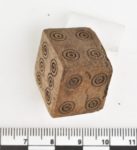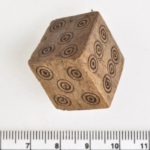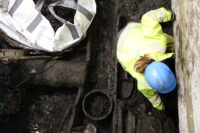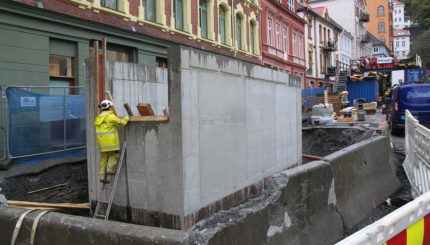 Archaeologists from the Norwegian Institute for Cultural Heritage Research (NIKU) excavating a medieval neighborhood of Bergen, Norway, have discovered a die with a non-standard numbering system (to put it extremely charitably) on four of its faces. Where the numbers one and two should be, there are an extra four and five instead giving this die a limited but suspiciously valuable range of rolling options: three through six.
Archaeologists from the Norwegian Institute for Cultural Heritage Research (NIKU) excavating a medieval neighborhood of Bergen, Norway, have discovered a die with a non-standard numbering system (to put it extremely charitably) on four of its faces. Where the numbers one and two should be, there are an extra four and five instead giving this die a limited but suspiciously valuable range of rolling options: three through six.
 In other words, somebody 600 years ago was either playing a game none of us today know about, or they had them some cheatin’ dice. The first interpretation is the least plausible. Plenty of dice have been found in Bergen from this period (more than 30), and none of them have idiosyncratic numeration like this one.
In other words, somebody 600 years ago was either playing a game none of us today know about, or they had them some cheatin’ dice. The first interpretation is the least plausible. Plenty of dice have been found in Bergen from this period (more than 30), and none of them have idiosyncratic numeration like this one.
“The dice were found close to a wooden street that dates back to the 1400s. So when looking at the context and the dice design, there is just as much chance that someone has got rid of it, as they have lost it,” says Per Christian Underhaug who is the project manager for the excavations in Bergen,
“This part of Bergen was a densely populated district with several inns and pubs, and it is not unlikely that there were lots of games being played in them,” says Underhaug.
It’s very likely, as a matter of fact. Gambling was so widespread in Bergen that in 1276 the city banned it. Violators were subject to having all the money on the table confiscated and paying a significant fine on top of that. The prohibition of gambling didn’t stop it, of course, which is why more than a century later people were still playing dice games and finding ways to sweeten the odds.
 The excavation is one of several taking place Vågsbunnen, one of the city’s lesser known medieval districts. Archaeologists hoped to make different finds here than in the other medieval areas of Bergen because it hasn’t been explored so thoroughly and because it was a working class neighborhood rather than a wealthy one. Also, once you dig down to cultural levels, the soil is very wet. This dig required use of a concrete coffer dam, lowered into the trench as soon as the team reached the first artifact layer, to keep them from being swamped. The challenges of excavating such an environment are offset by the potential preservation of organic material, as in the case of this discovery of the wooden die in fine condition.
The excavation is one of several taking place Vågsbunnen, one of the city’s lesser known medieval districts. Archaeologists hoped to make different finds here than in the other medieval areas of Bergen because it hasn’t been explored so thoroughly and because it was a working class neighborhood rather than a wealthy one. Also, once you dig down to cultural levels, the soil is very wet. This dig required use of a concrete coffer dam, lowered into the trench as soon as the team reached the first artifact layer, to keep them from being swamped. The challenges of excavating such an environment are offset by the potential preservation of organic material, as in the case of this discovery of the wooden die in fine condition.

This is probably what has been referred to as just “(an)other resource” ..as in ‘De Origine et situ Germanorum‘, it reads in chapter XXIV:
“Aleam, quod mirere, sobrii inter seria exercent, tanta lucrandi perdendive temeritate, ut, cum omnia defecerunt, extremo ac novissimo iactu de libertate ac de corpore contendant.”
“To throw the dice, strangely enough even when sober, they consider serious business, and so venturesome are they about gaining or losing, that, when every other resource has failed, on the last and final throw they stake the freedom of their own persons.” :no:
I am not a gambler, but would it not be better to have the identical faces opposite each other, rather than beside each other, where someone might notice?
You’d think any sober player would insist on examining the dice before the game began…
There are games with different number sequences on 6 sided dice. So it could be made for a game were different numbers needed to be rolled, not seen on a normal dice.
Since the 5 result is seen next to the other, I seriously doubt you could effectively cheat with these.